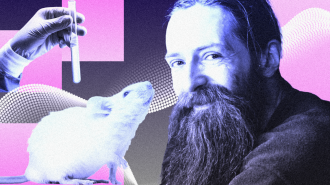Aubrey de Grey doesn’t look like your typical scientist. He has a chest-length ZZ Top beard and long, reddish hair pulled back into a ponytail. He doesn’t sound like your typical scientist either, eschewing the usual jargon for direct — some might say controversial — metaphors. That’s especially true when it comes to radical life extension and the profound effect he believes it can have on humanity. “Every day that I bring forward the defeat of aging,” he’s said, “it’s 30 World Trade Centers. It’s 110,000 people.”
De Grey, an artificial intelligence researcher turned biomedical gerontologist, views the body from an engineering perspective — as a machine that can be fine-tuned and repaired. And over the past two decades, through research and sheer force of personality, he’s helped propel the longevity movement from a fringe idea that advances in medicine can help humans live longer and better to a burgeoning research field backed by Silicon Valley billionaires.
Freethink sat down with de Grey to talk about the limits of longevity, the astronomical cost of life-extension research, and why he thinks we need a COVID-level war against aging.
You’ve said that aging is the world’s number one problem. What do you mean by that?
It started with my first wife, who was a biologist and who can take the credit for having accidentally taught me a lot of biology over the dinner table, but also for getting me to understand that aging was actually not universally viewed as a problem. I would say, “You don’t seem to be interested in aging.” And she would say, “No.” And I would say, “Why not?” And she would say, “Well, I’m a scientist, and aging is just decay. What fundamental truths about the universe am I going to discover by studying decay?”
When I was talking to other biologists and then, more generally, to people in the wider world, I would find the same absolute irrationality. Everyone would say, “Yes, suffering is bad.” And everyone would agree when I pointed out that aging causes far more suffering than anything else in today’s modern world added together, as well as more death. And yet they wouldn’t put those two things together and say, “That means aging is the world’s biggest problem.” I was so bewildered.
“People are terrified of getting emotionally invested in the idea that we might actually be able to bring aging under medical control.”
Aubrey de Grey
Longevity science was once taboo. Now it’s becoming more mainstream. What’s changed?
When I came into the field, radical life extension was something that nobody in academic gerontology would ever talk about. If you went anywhere near that idea, then you would never get funded. I think the reason why things have changed in the past 20 years is, first of all, there has been genuine progress in the research. We now have a lot of ways to make mice live a bit longer than they normally would, for example. The other thing is — if I can take any credit for it — it’s become a more acceptable thing to talk about simply because I’ve been making such a nuisance of myself over all these years and embarrassing people. And people have kind of noticed that there’s been no good response.
What is the biggest misconception about the longevity movement?
People are terrified of getting emotionally invested in the idea that we might actually be able to bring aging under medical control. They prefer to carry on deluding themselves into thinking that aging is a blessing in disguise or that it’s somehow woven into the fabric of the universe and is off limits to medicine, even in principle. A classic one is, “Oh, I wouldn’t wanna be old all that time.” Well, hello, we’re not gonna keep people alive in a sick state of health. Lifespan is a side effect of healthspan. Everybody knows that, and yet people will just let it completely go and just stick to these completely idiotic narratives.
You’ve approached anti-aging as an engineer, likening humans to cars. What do you mean by “damage repair” as it relates to our bodies?
The body is a machine. It’s obviously a really, really complicated machine. It’s a machine that we don’t have the blueprints for because it was created through evolution, but it’s still a machine. That means we should be able to extend — and indeed, transcend — the warranty period of the human body in just the same way that we do for simple man-made machines like cars or airplanes. We know that we have 100-year-old cars that did not get that way by being built to last a hundred years, but rather simply by preventative maintenance. And it took me a few years to realize that this was all everybody was missing.
The beauty of the damage repair approach is that it allows us to let damage accumulate at the normal rate. We just have to keep the damage down to a level that it doesn’t make us sick. Because the human body is spectacularly complicated, it actually creates a huge number of different types of damage. But we can classify these many types of damage into a manageable number of categories. The seven categories that I’ve been talking about since at least 2003 have very much not changed over time: loss of cells, cancer, senescent cells, mitochondrial mutations, waste products in cells, waste products that accumulate outside of cells, and loss of elasticity in tissues.
It was always clear to me that if you fix one type of damage, it’s going to let the body be a little bit better at slowing down the accumulation of other types of damage. But in the past five years or so, a torrent of reports have shown ways in which we can do damage repair in mice. And it actually extends life, which means that, even though they’re only fixing one particular type of damage, that somehow eases the pressure on the body and allows other types of damage to be improved. That’s great, because it means that we’ve got the chance to get a really big effect on mice — and eventually on humans — with a somewhat less-than-comprehensive panel of interventions.
“There’s going to be huge public demand, and that’s all we need at the end of the day.”
Aubrey de Grey
We’ve seen some promising potential anti-aging treatments in mice. But this research is astronomically expensive. Why? And how prohibitive will that be to progress?
The experiments are really expensive. The first study we did started two years ago. It was 1,000 mice and it cost $3.5 million. We’ve decided that the next experiment needs to be even bigger. It needs to be 2,000 mice. We’ve got some cost savings we’ve been able to incorporate into the study, so it won’t be $7 million, but it will be between $5 million and $6 million. These mice cost about $350 each, so that’s already $700,000, right?
A large part of why I’ve been able to do these studies and nobody else has is because I obtain my funding from philanthropy. Unfortunately, getting wealthy people to write big checks is not trivial. I spend most of my life trying to do that. At this point, I have nothing like enough money to do the second study. It’s very frustrating. But eventually I’ll get the money.
My job is eventually to persuade people — both wealthy people and less wealthy people, for that matter — that this is where they should be putting their dollars. That they should be contributing to the longevity crusade. And then I have to persuade them to actually spend that money in a way that makes sense.
We need a proper COVID-scale war on human aging. Vaccines for COVID were developed and distributed worldwide 10 times faster than had ever happened in the history of humanity. That’s a very big deal. And it only happened because everything we thought we knew about regulatory inertia and bureaucracy was just swept aside when the governments of the world perceived that was what the public wanted.
I believe we can get that once we’ve got these mice because the subject matter experts will go on Joe Rogan and Oprah Winfrey and Lex Fridman and MrBeast. And if they’re all saying the same thing, if they’re all demanding a war on aging right now, the influencers are gonna line up and demand it, too. And influencers are called influencers for a reason. There’s going to be huge public demand, and that’s all we need at the end of the day.
Is there a limit on how long humans can live?
There’re a lot of papers that get far too much attention that say things like there’s a natural limit to how long people can live. These papers are all based on the past. They’re based on how long people have actually lived so far. Well, duh, we kind of knew that there’s a natural limit on how long people can live in the absence of new medicine. It doesn’t say anything about how long we can keep people healthy — and thus alive — in the presence of new medicine.
If you’d asked someone building a car a hundred years ago, “Is there any chance that this car will survive for a hundred years?” They’d have laughed at you. But now, if you take someone who owns such a car, it’s been looked after a while, and it’s still working. And you ask them, “Will that car be still chugging along a hundred years in the future?” They’ll say, “Well, of course. Why not?” So obviously there’s no limit.
We’d love to hear from you! If you have a comment about this article or if you have a tip for a future Freethink story, please email us at [email protected].





















